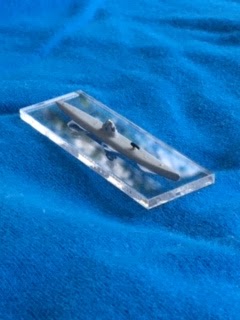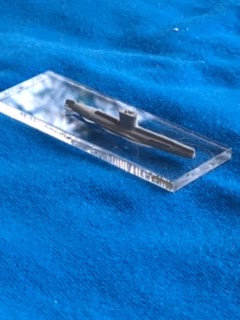The last element of the Zeppelin game
Ships play a layered and critical role in the combat history of lighter than airships. Several Zeppelins were actually shot down by British vessels. Most of the Zeppelins that were shot down by the British were shot down thanks to an assist from the Royal Navy. And of course the entire blimp side of the game arose as an effort to fight off the German submarine menace. In casting about for some 1/1250 ships to use in scale for the Zeppelins I discovered a company called Historia Emporium (here is their website ( https://www.greathistorygifts.com/ ). They have hundred of 1/1250 scale preconstructed and painted boats from various high end manufacturers like: Navis, Mercater, and Hai at a wide range of price points (starting at $3 and extending over $100). Apparently there is QUITE a market for tiny but hyper accurate models of vessels from both world wars and beyond. I had no idea.
All navies started The Great War with Anti-Aircraft weapons on ships. The newer the design, the more AA there would be. The British possessed a plethora of AA gun types and sizes from the QF (quick fire) 1, 1.5 and 2 pounders, which were literally scaled up versions of Maxim machine guns (and would eventually develop into the famous Bofors "Pom-Pom" guns). Interestingly, sailors and troops referred to these scaled up Maxims as "Pom-Pom" guns unofficially. All the way up to the 4 inch Naval Gun Mk V, which was the first purpose built Heavy AA gun. As the war went on these AA guns were retrofitted to more and more ships until the Germans learned to stay away from naval units as it was quite dangerous, but and still accidents do happen. The Royal Navy primarily served in assisting in the shooting down of Zeppelins in The Great War. The preferred German Tactic for a Zeppelin raid was to take the Zeppelin up, find a wind blowing the right way and let the wind carry them across the channel and over Britain. Then they would figure out where they were proceed to their target, drop their bombs and run for home. Royal Navy Patrols on occasion detected the Zeppelins drifting toward Britain and would radio back the direction and number seen. This would give the airplanes in Britain time to launch, climb and attack the Zeppelins on their way in. The last major Zeppelin raid, called the Greater Yarmouth Raid, which saw the destruction of the L70, was a rare event as the five Zeppelins powered their way to Britain, in a "V" formation, making no attempt at hiding what they were doing. They were easily seen on approach and the fighters sent in response. The L70 was just tardy climbing to safety leading to its destruction.
To complete this section of the enterprise I also decided to base the ships. I decided to go with clear plastic bases, which I discovered back with my Circus race game that Anton made a beautiful Spina and track to support. In trolling ebay I discovered Noble games selling a selection of clear bases in various sizes from a company called "Customeeple" for about $4 a bag (upwards of 18 bases in a bag depending on the size of the bases).
As a base line I decided to create some convoy sets. Here I have glued down a British flower class patrol boat (front right), a Swedish Torpedo boat (front left), a tender called the Vulcan (rear left) and an Austro-Hungarian tramp steamer (rear right) down on a 170mm by 110mm oval base.
On the second and final 170mm by 110mm oval base I have glued down a Japanese survey vessel (front right), another flower class patrol vessel (front left), a British Q ship (rear left) and a Swedish Torpedo boat destroyer (rear right). These two bases will serve as the general targets for either aerial or seaborne raiders to attack.
I could not resist a few oddities so here is a Spanish gunboat called the Laya. The convoys that sailed in WWI were a hodge podge of nations, crafts and colors so I wanted to trow in some spice. Even though Spain was neutral in the war I decided to include the boat for the "flavor"
Here is a single mounted Swedish Torpedo boat destroyer.and Swedish Torpedo boat. I purchased these because the two came as a package at a friendly price and I was more interested in getting the boats for the table then the specifics of the correct boats. A similar British Torpedo boat cost almost as much as these two. Also I wanted two of each of them so that I could mount the a separate mdel of each in case a hunter needed to be detached from the convoy to cover the escape of the convoy from a submarine attack.
Here are three German type VIIC submarines, actually a WWII sub, but they are identical to the submarines the Germans were using at the end of WWI (U-D3) , so I ran with them.
Here is a very early war German Kortling class Kerosene powered sub. Note the air intake stack behind the tower and the angled air flo vent aft. The U-9, which sank the 7th Cruiser (Live Bait) Squadron early in the war was one of these vessels.
Here is another early war German sub, this time a Mittel U MAN, diesel engine and armed with a deck gun in addition to the torpedoes.
And here we have a standard German type UD-1. Even carrying the net cutter on the bow, just in case they find themselves in a tight spot.
Speaking of the 7th Squadron (nicknamed the "Live Bait" squadron by its sailors) here is the Aboukir,
And the Cressy, which made up two of the three ill fated ships sunk by one German Kerosene powered submarine in what can only be called a slow motion disaster as the captains thought they had stumbled into a mine field and so stopped to render aid to sailors from the stricken ship(s) allowing the to sink all three cruisers over the course of an hour.
Unfortunately I could not get the Hogue and have all three but I did get the Euryalus which should have been there, but had returned to post with the ships destroyers and light cruiser escorts, leaving the other three to their fate.
Naturally, I could not resist a picture to recreate that horrible action.
Not wanting to be mean spirited or small minded I also picked up some allied submarines. Here is an English E class from early in the war.
Here is a British H class from the mid war era.
Here is a Nautillus class from the end of the war.
And here is one of the weirdest submarines ever. The Narwal class by the Russians. They have two torpedo tubes forward and two more aft. However, along each side the ship carries four "drop collar" torpedoes. Which could be angled and fired while submerged or on the surface.
Wanting to be fair and give everyone a chance for some fun, I also picked up a German Armored cruiser so that the allies can have something to pick on as well.
Here is a comparison shot of the German Subs.
Here is the family portrait of the allied subs.
And finally here is a comparison shot showing the early war German, a mid war Brit and the ultra tiny Russian sub all together.
The people at Historia Emporium are very friendly, pack their items perfectly and ship very quickly. Overall they were a pleasure to deal with. I highly recommend the Historia Emporium to anyone thinking if buy any of their products.
- Home
- Adventures in Blue Board and Foamcore
- The Lace Wars Project
- The Neulandia VSF campaign
- 28mm Plastic Figure reviews Perry, Victix WF etc etc
- Zvezda and Plastic Soldier Company Wargaming Models
- The Road to Leipzig
- Leipzig Orbats
- MDF Madness
- My Own Rules and other wacky ideas
- Fortified Places
- Book Reviews
- The Great Epicurean War
- Rich Uncle Pat and the (non-European) Cold War
- Old Rules Played by Old Dudes
- Those Magnificent Flying Machines





















Mike,
ReplyDeleteCheck out this company: http://www.alnavco.com/
They have been around since the 60's. Also they are based in Virginia
Nice! And they are pre-painted which is something I love
ReplyDeleteGary,
ReplyDeleteYes they do have a very impressive catalog, but those prices can make a heart skip a beat. However, if you needed a specific ship for some reason they certainly do have a selection.
Anton,
Glue to base - done! My favorite kind of wargame production work.
The clear bases are simple and effective.
ReplyDeleteThanks Gonsalvo, I like their simplicity. However, this time I ended up with some of that fogging that can happen on a couple of these so I need to figure out (are you listening Anton?) how to get that off if such is possible. But now it is on to 'bigger' and more 'ranging' projects for the blood red skies game.
ReplyDeleteSuperglue fogging is due the to glue evaporating and adhering to skin oils on nearby surfaces. It can be corrected when it is happening with nail polish remover and a paintbrush, but I never notice it until later. If you have some Future Floor Polish you can apply a tiny bit to the fogged area, this should gloss out the glue crystals that give it the white appearance. It isn't a perfect answer but it IS an improvement. To avoid fogging in the future wash your hands and the objects to be glued in harsh dishwashing soap and then handle as little as possible before gluing to avoid transferring skin oils onto the surfaces.
DeleteI certainly do have that elixir. I will give it a whirl.
ReplyDeleteAircraft modeler dip their canopies in Future. One you can paint over future. Two, super glue will not gas the plastic as John said.
ReplyDeleteGary thanks for that tip, I will keep it in mind for the future.
ReplyDelete